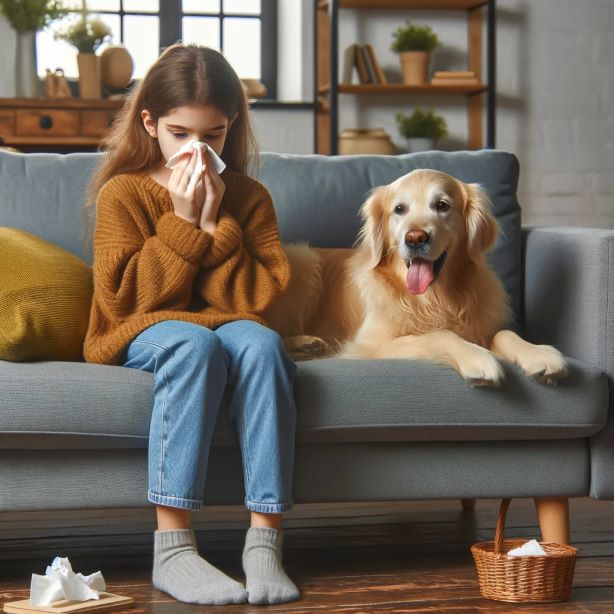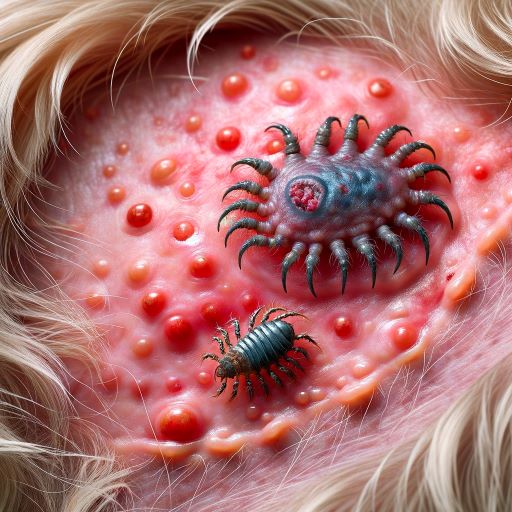How to Calm Dog Allergies: A Comprehensive Guide

Dog allergies are a significant concern for many pet owners, manifesting through various symptoms that can affect a dog’s quality of life. Understanding how to calm dog allergies is essential for providing relief and comfort to your furry friend. This article will explore effective methods and strategies to manage and calm dog allergies, ensuring your pet leads a happy, healthy life.
Understanding Dog Allergies
Dog allergies occur when a dog’s immune system overreacts to foreign substances, known as allergens. These reactions can cause symptoms ranging from mild to severe, affecting the dog’s skin, digestive system, and respiratory health.
Dog allergies are a common health issue affecting canines of all breeds and ages. These allergies occur when a dog’s immune system overreacts to substances in its environment, which are normally harmless to most animals. This overreaction can cause a range of symptoms that can significantly impact a dog’s quality of life. Understanding dog allergies and learning how to calm dog allergies is crucial for pet owners to provide the best care for their furry companions.
Types of Dog Allergies
Dog allergies can be categorized into several types, each triggered by different allergens. The most common types include:
- Environmental Allergies (Atopic Dermatitis): Caused by allergens such as pollen, mold spores, dust mites, and dander. These allergies often cause skin irritation and are more prevalent during certain seasons, though some dogs may experience symptoms year-round. Finding ways on how to calm dog allergies is essential, especially for dogs suffering from environmental allergens.
- Food Allergies: Reactions to specific ingredients in a dog’s diet. Common allergens include proteins from beef, chicken, dairy, and certain grains. Food allergies can lead to gastrointestinal issues as well as skin problems.
- Flea Allergy Dermatitis: A severe allergic reaction to flea bites, specifically to the saliva of the flea. Even a single bite can trigger intense itching and skin irritation for weeks.
- Contact Allergies: Less common, these arise from direct contact with substances like certain fabrics, rubber, plastics, or even specific shampoos and grooming products. Contact allergies usually cause localized skin reactions.

Common Allergens for Dogs
Here’s a table analyzing common allergens for dogs, including triggers, symptoms, and strategies on how to calm dog allergies:
| Allergen Type | Common Triggers | Symptoms | How to Calm Dog Allergies |
|---|---|---|---|
| Environmental | Pollen, dust mites, mold spores | Skin irritation, respiratory issues | Keep home clean, use air purifiers, regular bathing |
| Food | Beef, chicken, dairy, grains like wheat | Gastrointestinal issues, skin problems | Elimination diet, avoid offending foods |
| Flea Allergy Dermatitis (FAD) | Flea saliva | Intense itching, skin infections | Regular use of flea prevention treatments, maintain a clean environment |
| Contact | Synthetic fibers, rubber, plastics, certain cleaning products | Skin irritation at contact sites | Use hypoallergenic materials, natural cleaning products |
This table provides a concise overview of how to identify and manage the most common allergens affecting dogs. Understanding these allergens and implementing strategies to reduce exposure and alleviate symptoms are crucial steps in learning how to calm dog allergies.
Read more: How to Train Stubborn Dog With These Simple Steps
Common Symptoms of Dog Allergies
Understanding the symptoms and learning how to calm dog allergies through proper care and management can significantly improve your dog’s quality of life. It involves a combination of veterinary support, lifestyle adjustments, and attentive care to ensure that your dog can lead a comfortable and happy life despite their allergies. They are:
Skin Irritation and Inflammation: One of the most noticeable signs of allergies in dogs is skin irritation. Affected dogs may exhibit red, inflamed skin, often accompanied by scratching, licking, or biting at the irritated areas. This can lead to hair loss and, in severe cases, skin infections. Addressing this symptom promptly is vital in understanding how to calm dog allergies.
Ear Problems: Dogs with allergies may suffer from ear issues, such as redness, itchiness, and inflammation inside the ear canal. Chronic ear infections can also occur, causing discomfort and potential hearing loss if not treated. Managing these ear problems is an important aspect of how to calm dog allergies.
Gastrointestinal Symptoms: Food allergies, in particular, can lead to symptoms like vomiting, diarrhea, and excessive gas. These digestive issues not only affect the dog’s comfort but also its overall health and nutrition. Identifying and eliminating the offending food allergen is crucial in these cases.
Respiratory Symptoms: Though less common, some dogs with allergies might experience respiratory symptoms, especially if the allergies are related to inhaled substances. Sneezing, coughing, and wheezing can occur, reminiscent of human hay fever.
How to Calm Dog Allergies by Addressing Symptoms
To effectively calm dog allergies, it’s important to take a proactive approach in managing the symptoms:
- Consult a Veterinarian: A professional diagnosis is essential. A vet can recommend specific treatments such as antihistamines, corticosteroids, or other medications to manage the symptoms and provide relief.
- Dietary Adjustments: For food-related allergies, an elimination diet can help identify the allergens causing gastrointestinal symptoms. Switching to a hypoallergenic diet may be necessary to alleviate these issues.
- Skin and Ear Care: Regular bathing with hypoallergenic or medicated shampoos can soothe irritated skin and remove allergens from the fur. For ear problems, cleaning and medication prescribed by a vet can prevent infections and reduce inflammation.
- Environmental Management: Minimizing exposure to environmental allergens can significantly reduce respiratory and skin symptoms. This includes maintaining a clean home, using air purifiers, and avoiding walks during high pollen counts.
Understanding the symptoms and learning how to calm dog allergies through proper care and management can significantly improve your dog’s quality of life. It involves a combination of veterinary support, lifestyle adjustments, and attentive care to ensure that your dog can lead a comfortable and happy life despite their allergies.
Read more: How to Train Dog to Poop in Designated Areas?
Preventing Allergies in Dogs

Preventing allergies in dogs is a proactive approach that can significantly improve the quality of life for our canine companions. By understanding and implementing strategies to reduce the exposure to allergens, pet owners can play a crucial role in managing and even preventing the onset of allergic reactions. This proactive stance not only aids in preventing allergies but also serves as a foundational strategy on how to calm dog allergies should they arise. Here’s a deeper look into preventive measures and how they align with calming dog allergies.
Early Exposure and Immunization
Introducing your dog to various environments and substances at a young age can help build a robust immune system. This early exposure strategy is akin to immunization, where the goal is to familiarize the dog’s immune system with potential allergens in a controlled manner. It’s a preventive measure that, in the long run, contributes to how to calm dog allergies by reducing the likelihood of severe reactions to common allergens.
Optimal Nutrition for Immune Support
A well-balanced diet plays a pivotal role in maintaining a dog’s immune health, which is directly related to how to calm dog allergies. Incorporating foods rich in omega-3 fatty acids, antioxidants, and other essential nutrients can bolster the immune system, making it less likely for allergies to develop. For dogs with existing sensitivities, identifying and eliminating specific food allergens from their diet can prevent allergic reactions and contribute significantly to calming dog allergies.
Environmental Control
Managing the environment your dog lives in is another critical aspect of preventing allergies. Regular cleaning to reduce dust, pollen, and dander in the home, using hypoallergenic bedding, and maintaining a strict flea control regimen are all effective strategies. By minimizing exposure to these common allergens, you’re not only working towards preventing allergies but also employing a key method on how to calm dog allergies by removing the triggers that cause discomfort.
Regular Veterinary Care
Routine check-ups with a veterinarian can help catch potential allergies early on and provide an opportunity to implement preventive measures before the condition escalates. Vaccinations, flea control, and even allergy testing can be part of a comprehensive health plan. Regular veterinary care is essential for understanding how to calm dog allergies through both preventive measures and timely interventions.
Stress Management
Stress can exacerbate allergic reactions, making it harder to calm dog allergies once they occur. Implementing regular exercise routines, providing mental stimulation, and ensuring your dog has a calm, safe environment can reduce stress levels. Lower stress levels support a healthier immune system, which is less prone to overreacting to allergens, thereby preventing allergies or reducing their severity.
Advanced Care and Alternative Therapies
Advanced care and alternative therapies have become increasingly popular among pet owners seeking holistic ways to manage and alleviate their dogs’ allergy symptoms. While conventional treatments remain the cornerstone of veterinary care, these innovative and supplementary approaches can offer additional relief and comfort to dogs suffering from allergies. Understanding how to integrate these methods effectively is key to creating a comprehensive plan on how to calm dog allergies. Here’s an exploration of some of these advanced care options and alternative therapies, emphasizing their role in calming dog allergies.
Advanced Care Options
Immunotherapy: Often considered a more advanced treatment for allergies, immunotherapy involves exposing the dog to gradually increasing doses of the allergen, either through injections or oral drops. This method aims to desensitize the dog’s immune system to the allergen over time. Immunotherapy is a long-term strategy that can significantly reduce the severity of allergic reactions, playing a crucial role in how to calm dog allergies for many pets.
Novel Medications: Newer pharmaceuticals, such as biological therapies that target specific pathways in the allergic response, are also on the rise. These medications can offer targeted relief without some of the side effects associated with traditional steroids, providing another tool in how to calm dog allergies effectively.
Read more: dog cave bed, all you need to know
Alternative Therapies
Herbal Remedies: Many pet owners turn to herbal remedies for a natural approach to calm dog allergies. Herbs like nettle, licorice root, and quercetin have natural antihistamine and anti-inflammatory properties that can help alleviate symptoms. It’s important to consult with a veterinarian knowledgeable in herbal medicine to ensure these remedies are safe and effective for your dog.
Acupuncture: Acupuncture is another alternative therapy that has shown promise in calming dog allergies. By stimulating specific points on the body, acupuncture can help balance the immune system and reduce inflammation, providing relief from allergy symptoms. Sessions should be conducted by a certified veterinary acupuncturist to ensure the best outcomes.
Omega-3 Fatty Acids: Supplementing a dog’s diet with omega-3 fatty acids can help improve skin health and reduce inflammation, which is beneficial in calming dog allergies. These supplements, derived from fish oil or flaxseed oil, can be a simple yet effective addition to your dog’s allergy management plan.
Probiotics: The health of the gut microbiome is increasingly recognized for its role in overall immune health. Probiotics can support a healthy digestive system, which, in turn, can help modulate the immune response and calm dog allergies. Selecting the right probiotic strain is essential for achieving the desired benefits.

Combining Treatments for Optimal Results
When exploring how to calm dog allergies through advanced care and alternative therapies, it’s crucial to adopt a holistic view. Combining conventional treatments with these alternative approaches can often provide the best relief for allergy symptoms. Collaboration with a veterinarian who is open to and knowledgeable about these various treatments is essential for tailoring a care plan that addresses the unique needs of your dog.
Read more: Retractable Dog Leashes: A Comprehensive Guide
Conclusion
In wrapping up the discussion on how to calm dog allergies, it’s evident that a multi-pronged approach is key to effectively managing and alleviating the symptoms associated with canine allergies. From preventive measures to mitigate exposure to allergens, to incorporating advanced care and alternative therapies, each strategy plays a crucial role in ensuring the well-being of allergic dogs. The journey to calm dog allergies involves close collaboration with veterinary professionals, who can provide tailored advice and treatment plans suited to each individual dog’s needs. Pet owners are empowered through knowledge and resources to make informed decisions about their pets’ health, leading to significant improvements in their quality of life. Emphasizing the importance of understanding and addressing the unique factors contributing to each dog’s allergies, this comprehensive approach underlines the commitment required to calm dog allergies, fostering a healthier, happier life for our canine companions.
faq
Can I live with a dog if I am allergic?
Living with a dog while allergic is possible with measures like choosing hypoallergenic breeds, maintaining a clean environment, and using air purifiers to reduce allergens.
How can I make my dog hypoallergenic?
Making a dog hypoallergenic involves regular grooming, bathing the dog to reduce dander, using hypoallergenic dog shampoos, and maintaining a clean home environment to minimize allergens
Can you overcome dog allergies?
Overcoming dog allergies can involve medical interventions such as allergy shots (immunotherapy), taking antihistamines, and implementing strict environmental control measures to reduce exposure.
Can you desensitize yourself to dog allergies?
Desensitizing yourself to dog allergies is possible through gradual exposure under medical supervision, allergy shots (immunotherapy), and adopting lifestyle changes to minimize allergen exposure.





